Recent Water Damage Posts
Water Damage Solutions in Lousia
9/19/2022 (Permalink)
If you are a contractor, you probably want to avoid water issues, like a broken pipe that requires costly and time-consuming fixes, such as hiring a water pipe repair person. To protect your projects from requiring a water cleanup company, you should take the proper preventative steps. This means being proactive.
Identify Water Sources
Water leaks can sometimes happen when you are testing a building's systems and will require that you fix them with appropriate water pipe repair measures. The most common sources you should watch include:
- Water distribution fixtures
- Roof drains
- Sewer hookups
- HVAC fluid systems
- Fire sprinklers
Create a Plan
To avoid performing a water pipe repair, contractors should take the potential water sources and create a plan to mitigate threats. These methods of mitigation should also be included in your project budget since they are necessary precautions.
Use Water Damage Prevention Tools
When building, there are water damage prevention tools that can limit the amount of damage a site sees. It is recommended that contractors use at least two of the readily available tools to reduce water damage.
Conduct a Shutdown Inspection
To ensure that the building is safe, a shutdown inspection should be conducted every time your crew leaves the site in Locust Hill, VA. This inspection should be conducted according to a checklist that incorporates potential threats and your mitigation plan. It should also be conducted if a storm is approaching.
All project staff should conduct their part of the checklist before leaving the site. The responsibility can be handed to one staff member to ensure completion if necessary. However, this may not be feasible on larger projects. It is also a great idea to train new employees on the preventative measures used to reduce water damage and why they are necessary.
By incorporating these strategies, contractors can reduce the amount of damage they experience from flooded worksites. This is because they know where the potential threats are and plan to deal with them using the proper tools. Additionally, contractors should perform a shutdown inspection to ensure a site is waterproofed before leaving it.
If you suspect water damage in your home or business, don't hesitate to call the restoration experts at SERVPRO of Louisa, Orange, and Madison Counties (540)513-3111
Protecting Your Home from Water Damage
8/29/2022 (Permalink)
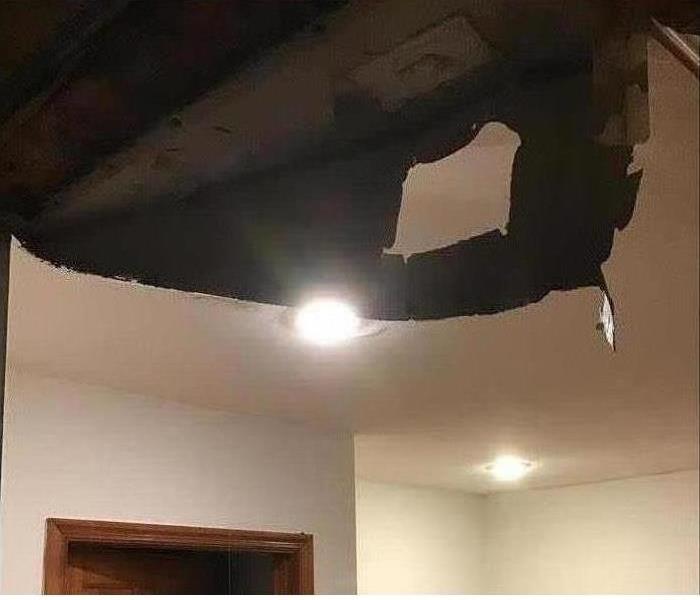 If you have water damage call SERVPRO of Louisa, Orange and Madison counties (540) 513-3111.
If you have water damage call SERVPRO of Louisa, Orange and Madison counties (540) 513-3111.
Our homes are a big investment and it's important make every effort to take care of them. Maintaining your house can go a long way toward helping you avoid major catastrophes, including the following:
Water in home
Roof in disrepair
Electrical fire in the kitchen
Mold in home
Even with taking precautions and regular maintenance damage can happen to our homes. This means there may be times when you have to turn to a professional remediation team to help you clean up water damage. You may be able to prevent some water dilemmas by keeping the following tips in mind.
Be Observant
An excess amount of moisture from a broken pipe can leave you with a lot of damage if you don't catch it early. If you're vigilant around your house, you'll notice signs of leaks before the water introduces mold into your space. Watch for water stains on your walls and ceiling. Look for other signs of moisture, such as peeling paint and bubbling flooring.
Have Inspections
Your plumbing, HVAC unit and appliances could malfunction and lead to water in home. If you have these parts of your house inspected annually, you can reduce the chances of a flood happening. A plumber can look at your pipes to ensure there are no clogs or breaks you need to know about. An HVAC repairman can assess your heating and cooling units to check for signs of wear and tear. You should make sure your dishwasher, washing machine and refrigerator are inspected too because these appliances can have faulty hoses or broken water supply lines that lead to flooding.
Make a Plan
Sometimes knowing who you would call for a pipe cleanup can help you prevent major damage to your home. Figure out which restoration team you want to turn to before flooding starts, so you can react as quickly as possible. Call SERVPRO of Louisa, Orange and Madison counties (540) 513-3111.
Water Damage and Flooded Basements
6/15/2022 (Permalink)
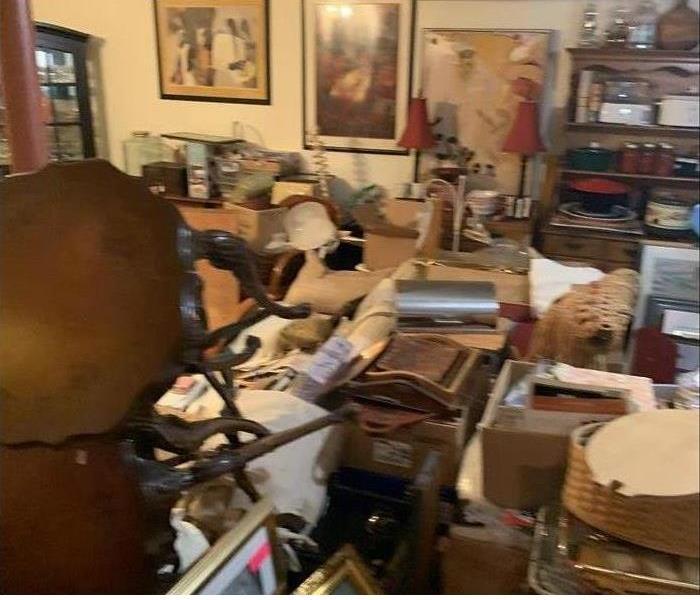 A basement full of stored items can be a mess when you have a flood. SERVPRO of Louisa, Orange and Madison Counties (540) 513-3111.
A basement full of stored items can be a mess when you have a flood. SERVPRO of Louisa, Orange and Madison Counties (540) 513-3111.
If you have water damage in your home there is a lot to consider, that's why it's important to call a reputable restoration service. Consider what you will do with wet, damaged items that can be saved. Our pack out and content cleaning services might be the answer.
This photo is an example of a flooded basement. The basement was completely full of contents. What do you do when you have this much content in a flooded basement?
SERVPRO of Louisa, Orange and Madison Counties provides pack out and content cleaning services. We carefully document, wrap and protect each large item and box all smaller items. Once the home is packed out, the contents are transported to our climate controlled warehouse where we unwrap, clean and process the affected items, then wrap and protect the items again to be delivered back to the client once all repairs are performed.
This photo shows a job where we performed the pack out services, then we mitigated and dried this basement before any microbial growth began. Once the repairs are performed in this home, and we deliver all of the customers household goods, this basement will be back to preloss condition, or as we say, " Like it never even happened."
SERVPRO of Louisa, Orange and Madison Counties is locally owned and operated, this means we know the community and can get to your emergency quickly. We can respond immediately to your emergency and have the expertise to handle your restoration or cleaning needs. Our staff is highly trained in property damage restoration, and we are an IICRC Certified Firm.
In some cases, water damage can lead to mold. If you suspect mold, be sure to call us right away. We have the knowledge, tools and track record to effectively remediate mold in your home or business.
SERVPRO of Louisa, Orange and Madison Counties (540) 513-3111.
When You Are Out of Town, A Small Leak Can Be a Big Problem
3/10/2022 (Permalink)
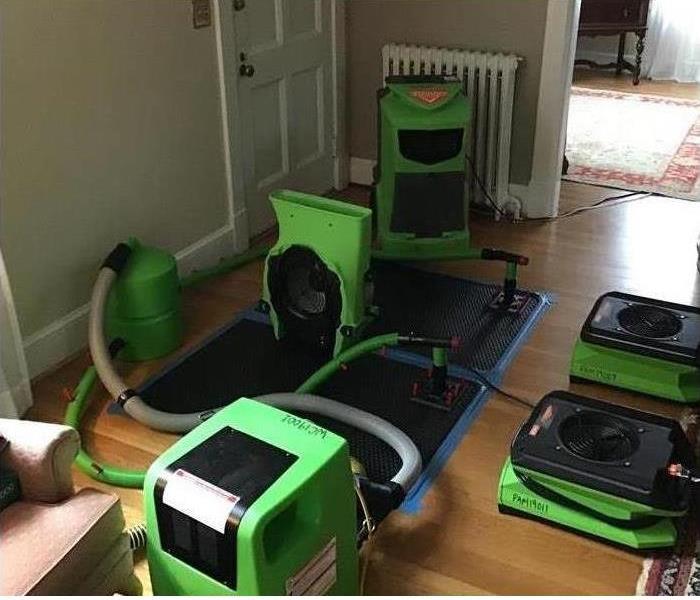 We were able to save the 80-year-old white oak floors
We were able to save the 80-year-old white oak floors
This homeowner went out of town for vacation, while they were away the toilet supply line broke. This is a common occurrence and can easily be avoided by turning the main water supply valve off when leaving the home for several days.
SERVPRO of Louisa, Orange, & Madison was contacted by a local insurance agent asking if we could save these floors. Prior to contacting our franchise, another competitor had been to the home and had proposed that these floors needed to be removed and could not be saved.
Our crew arrived the same day and we set up the Injectadry system with rescue mats. We also placed a couple fans and a dehumidifier. After 3 days of drying, we removed the moisture from the floors, the floors had no cupping and were left in preloss condition.
The homeowner was extremely pleased to know we were able to save the 80-year-old white oak floors that were just refinished 2 months prior to the loss. This is another example of how SERVPRO training separates us from the competition, we always try to restore before we remove, if possible.
Our technicians have extensive cleaning and restoration training and can make your property look its best. Whether your home needs emergency flood damage or your upholstery cleaned, you can depend on us.
A fast response lessens the damage, limits further damage, and reduces the restoration cost. SERVPRO of Louisa, Orange and Madison County, (540) 513-3111. Since we are locally owned and operated, we are able to respond quicker with the right resources, which is extremely important.
Basement Flooding and Concerned Homeowners
2/14/2022 (Permalink)
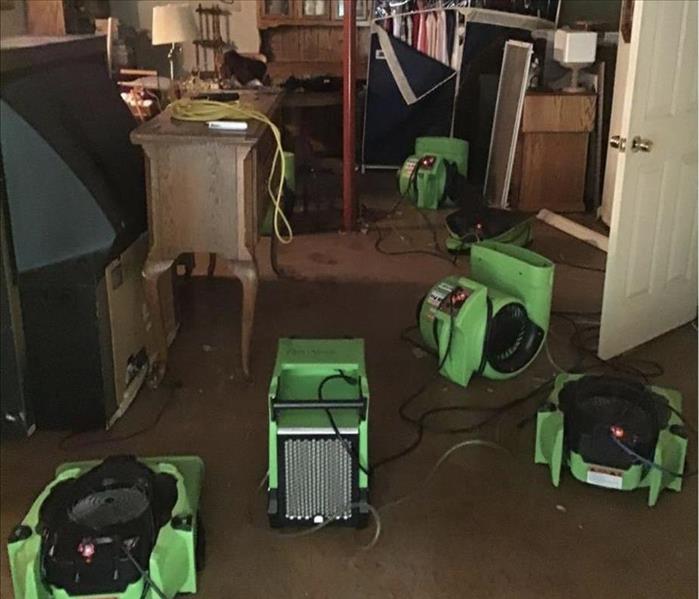 If you have water damage in your basement, call the experts at SERVPRO of Louisa, Orange and Madison County, (540) 513-3111.
If you have water damage in your basement, call the experts at SERVPRO of Louisa, Orange and Madison County, (540) 513-3111.
Basement water damage is a big concern for many homeowners. What can you do to avoid this expensive problem?
Here are a few tips:
Keep your gutters clean and check around your home for pooling water.
Clean your downspouts regularly, and make sure all downspouts drain 5 to 6 feet away from your exterior walls.
Seal any cracks in the walls and floors in your basement to keep it dry.
Invest in a backup drainage system like a battery-powered sump pump.
If you experience heavy rainfalls, avoid using water during storms.
If you have water damage in your basement or anywhere in your home call SERVPRO of Louisa, Orange and Madison County, (540) 513-3111, so we can get a trained technician to you. A delay of just a few hours might increase the severity of the water damage.
Check to see if your basement is safe to enter. You should never enter a flooded area while the power is still on. Make sure to shut off any power, including electricity and gas, before going into the flooded basement. If the water appears to be over an inch deep, it may be best to wait until the water has been pumped out to enter the basement.
Remember, when you are dealing with water damage, immediate action is critical. SERVPRO of Louisa, Orange and Madison County, is available 24 hours a day for water emergencies, large or small. Flooding and water emergencies don’t wait for regular business hours and neither do we. SERVPRO of Louisa, Orange and Madison County, provides emergency cleaning and restoration services 24 hours a day, 7 days a week.
Basements are inherently prone to flooding because they are the lowest level of your home. They are normally built partly or entirely below ground level. A basement can flood at any time, although flooding most often occurs during heavy rainfall.
If you have questions about water damage or restoration, call SERVPRO of Louisa, Orange and Madison County, (540) 513-3111.
How To Flush a Water Heater
11/25/2021 (Permalink)
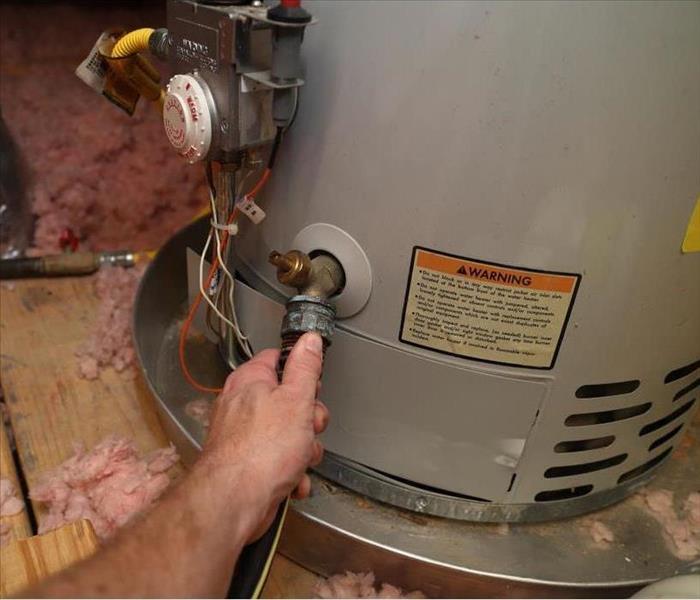 A water heater is an essential element of any home.
A water heater is an essential element of any home.
What Is the Best Way to Flush a Water Heater?
A water heater, sitting in a dark closet or basement, is easy to forget. If you want to ensure the longevity of your hot water tank, then you may want to follow the steps below to flush the system, clearing out harmful sediment and debris.
1. Turn Off and Prep the Tank
To perform a water heater flush, you may want to have a garden hose and screwdriver handy. Additionally, you will need to prep the tank by first turning off the power and/or gas. Then, attach one end of the garden hose to the tank, and place the other end in a drainage area that can tolerate the hot water.
2. Flush the Tank
To empty the water heater, open the drain valve on the tank and make sure the water is escaping through the hose to the drainage area. After a few minutes, turn the hot water on from the nearest faucet. A couple of minutes after this, turn off the water supply. Once the water stops exiting the garden hose, turn on the water supply for only a couple of minutes to flush out the system again.
3. Refill the Tank
When all debris from the tank has drained, close the drain valve and turn on the water supply. Once the water pressure returns to the open faucet, you can be confident that the tank is filled. Be aware that the water from the tap will be inconsistent at first as air is flushed from the lines.
4. Turn On the Tank
Turn the power/gas back on only when the tank is full to protect the integrity of the system. Once the heat is on and the water is flowing strong, you can turn off the running faucet. If you are experiencing problems with the water pressure or the heating element of the tank, you may want to call a professional in Rhoadsville, VA, to examine any possible causes.
A water heater is an essential element of any home, and flushing the system ensures its continued use. Following the steps above, you can perform this task yourself and maintain your tank for years to come.
Fire Sprinklers and Accidental Discharge: What to Do If the Fire Sprinklers Go off Accidentally?
9/26/2021 (Permalink)
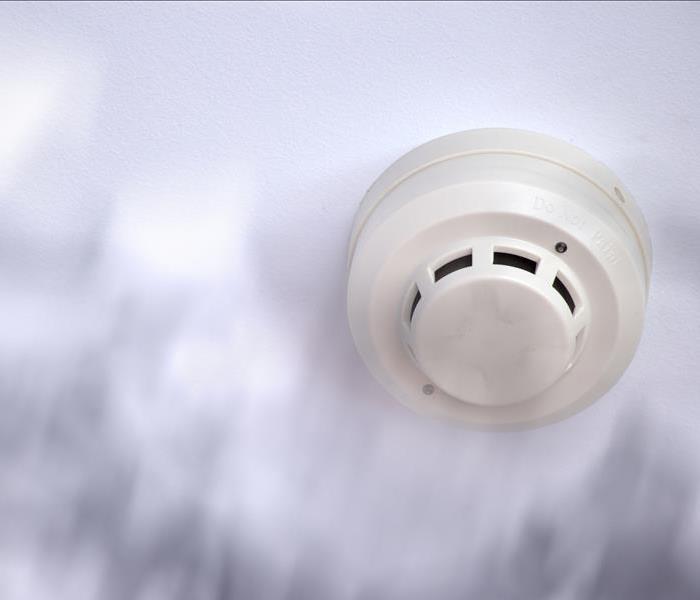 In case of accidental discharge, it is important to keep the above steps in mind to speed up the recovery process and get back to normal operations.
In case of accidental discharge, it is important to keep the above steps in mind to speed up the recovery process and get back to normal operations.
Fire sprinklers are an excellent safety measure that is most likely required by law in Rhoadsville, VA, but, while they are a lovely preventative and protective asset, in the case of accidental discharge, they can cause flooding and significant water damage. For most business owners who experience this unintentional disaster, they will typically want to know the process they should adhere to after.
1. Call Your Insurance Company
The first step is to call your insurance company. Most insurance companies will cover damage caused by a faulty or defective sprinkler system, but they will want to ensure that the responsibility lies with the manufacturer and not with the business owner. As the owner, insurers expect you to maintain your equipment, and if there is any sign of persistent issues resulting in the malfunction of the sprinkler system, most insurers will place the financial burden on the property owner.
2. Document the Incident and Any Damage
After you’ve called your insurance company, it is beneficial to document both the incident and the flooding or damage caused by the faulty fire sprinklers. You can document the incident by talking with any witnesses and finding out what occurred before the malfunction. Additionally, you may want to take photos of the area and any damaged merchandise to show as evidence and proof of loss.
3. Cleanup
Once you and your insurance company have determined responsibility, you can begin the cleanup process. Several companies specialize in water damage and can help you in your restoration efforts. The important thing, however, is to get your business back on track as fast as possible to minimize any significant interruption costs.
Fire sprinklers are essential and often required elements of a business, but, while they do require routine maintenance, they can malfunction, causing flooding and potential business interruption. In case of accidental discharge, it is important to keep the above steps in mind to speed up the recovery process and get back to day-to-day operation.
3 Ways Secondary Damage Can Affect Your Home After a Flood
8/30/2021 (Permalink)
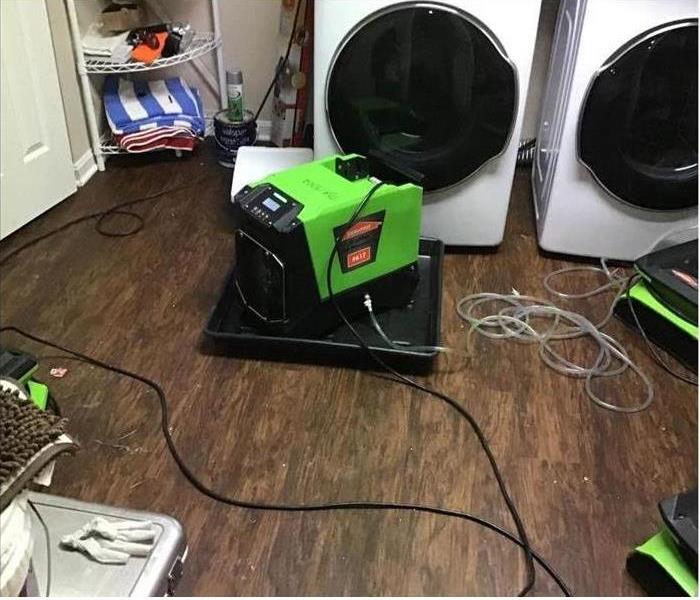 We have expert equipment to clean up water and flood damages in homes.
We have expert equipment to clean up water and flood damages in homes.
3 Ways Secondary Flood Damage Can Affect Your Home
The aftereffects of a flood at your Rhoadsville, VA, home can be devastating. Estimating repair costs, sorting through damaged items and gathering data for a flood insurance claim are just a few things you might be dealing with. However, even as you try to handle the aftermath, water damage could be creating issues that you may not notice until days later. From black mold to warping and discoloration of your home's surfaces, secondary damage can exacerbate your flooding woes.
1. Mold growth
After a flood, the high humidity in the area can cause rapid mold growth on walls and other surfaces. Black mold is especially common after flooding, and if you encounter this issue, it is wise to call in a storm cleanup and restoration company to remove it. This can prevent the spores from spreading to other areas, where it may take hold out of sight.
2. Warping
Once flood waters recede, items with porous surfaces, such as wood, can retain moisture and warp. This damage may not occur right away, but over time, you may notice the effects in hardwood floors and wooden furniture. Your countertops may also suffer discoloration if they were constructed with a porous material, such as polished concrete.
3. Musty or Wet Odors
Secondary damage, such as unpleasant odors left behind from dirty water, may not be noticeable until days or weeks after a flood. These odors can linger in furniture, carpeting or even in your home's interior walls, where insulation may be wet and rotting. Restoration technicians have specialized equipment that can help them locate the source of these wet or musty odors and eliminate them.
The immediate effects of a flood in your Rhoadsville, VA, home can be difficult to deal with. However, problems that may crop up days or weeks afterward, such as black mold and wood rot, can be equally hard to handle, and being aware of them may help you be more vigilant about their presence once flood waters recede.
How To Know When It Is Time for a Plumbing Overhaul
3/16/2021 (Permalink)
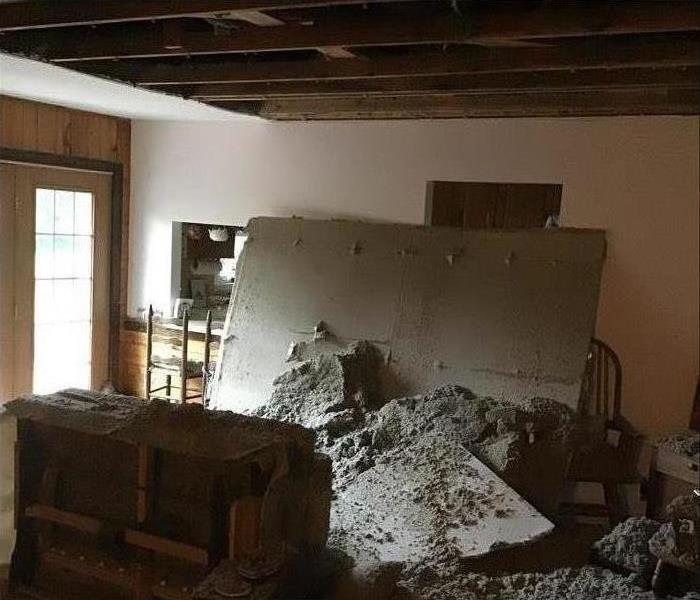 Collapsed ceiling due to water damage in Louisa, VA.
Collapsed ceiling due to water damage in Louisa, VA.
How To Know When It Is Time for a Plumbing Overhaul
Many people ignore the home's plumbing system until it is too late. This often leads to repeated repairs for leaks, pipe breaks and similar issues. The problem with this approach is that some plumbing issues can lead to significant water damage in a home. Supply line damage is one example of a problem that could release hundreds of gallons into a home in Louisa, VA. Though this water is likely to be clean water, it still has the power to inflict damage on flooring, walls, insulation and furniture. In some situations, a complete plumbing system overhaul might be the best solution.
Signs of Big Trouble
An occasional bathroom leak is fairly common and nothing to cause undue alarm. However, if the plumbing system experiences frequent breaks, especially in difficult-to-access locations, a replacement system might be in order. Still, it is important to carefully assess the situation by considering the following factors:
- The age of the plumbing system
- The lifespan of piping materials
- The condition of the joints and fittings
- The presence of corrosion
Each type of piping material has an expected lifespan. Supply line damage is rarer in PVC, copper and cast iron piping that is less than 50 years old. Brass and galvanized steel piping wear out more quickly.
A Reasonable Solution
While avoiding a supply line leak is important, a major replacement of plumbing is a big job. It can make sense to look for reasonable opportunities to replace plumbing components. For example, remodeling projects are great times to include a plumbing upgrade, especially if walls are being removed.
If major supply line damage does occur, calling in a water damage restoration company is the best way to avoid significant harm to a home. Trained technicians will remove standing water quickly and dry out the home to prevent future damage such as mold growth. Avoiding water damage is a worthy goal as is minimizing the consequences of a water disaster.
Preventing Water Damage During Construction
2/16/2021 (Permalink)
 Prevent water damage during construction in Locust Hill, VA.
Prevent water damage during construction in Locust Hill, VA.
If you are a contractor, you probably want to avoid water issues, like a broken pipe that requires costly and time-consuming fixes, such as hiring a water pipe repair person. To protect your projects from requiring a water cleanup company, you should take the proper preventative steps. This means being proactive.
Identify Water Sources
Water leaks can sometimes happen when you are testing a building's systems and will require that you fix them with appropriate water pipe repair measures. The most common sources you should watch include:
- Water distribution fixtures
- Roof drains
- Sewer hookups
- HVAC fluid systems
- Fire sprinklers
Create a Plan
To avoid performing a water pipe repair, contractors should take the potential water sources and create a plan to mitigate threats. These methods of mitigation should also be included in your project budget since they are necessary precautions.
Use Water Damage Prevention Tools
When building, there are water damage prevention tools that can limit the amount of damage a site sees. It is recommended that contractors use at least two of the readily available tools to reduce water damage.
Conduct a Shutdown Inspection
To ensure that the building is safe, a shutdown inspection should be conducted every time your crew leaves the site in Locust Hill, VA. This inspection should be conducted according to a checklist that incorporates potential threats and your mitigation plan. It should also be conducted if a storm is approaching.
All project staff should conduct their part of the checklist before leaving the site. The responsibility can be handed to one staff member to ensure completion if necessary. However, this may not be feasible on larger projects. It is also a great idea to train new employees on the preventative measures used to reduce water damage and why they are necessary.
By incorporating these strategies, contractors can reduce the amount of damage they experience from flooded worksites. This is because they know where the potential threats are and plan to deal with them using the proper tools. Additionally, contractors should perform a shutdown inspection to ensure a site is waterproofed before leaving it.
Understanding the Different Levels of Sewage Damage
1/13/2021 (Permalink)
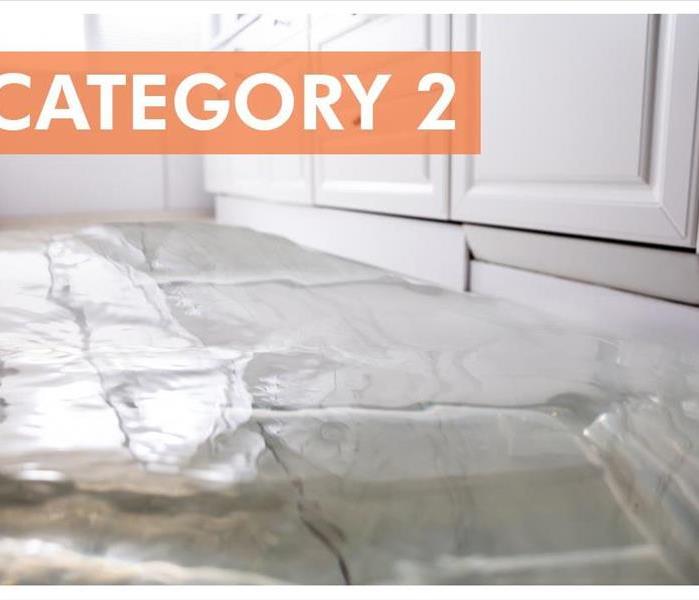 Category 2 water damage comes from a dirty water source
Category 2 water damage comes from a dirty water source
As a homeowner, it’s important to be prepared for various types of damage in your home, including sewer backup. Whether you’re dealing with a flooded toilet or a faulty dishwasher, you should recognize that you’re in the middle of an emergency situation. If you ever have to deal with sewage in your residence in Burr Hill, VA, you need to reach out to professional experts in sewer cleanup to address this issue quickly and thoroughly. They will know the proper approach based on the type of contaminated water or sewage damage level found.
Exploring Different Levels of Water Contamination
Sewage damage is categorized based on three different levels or types of contaminated water:
- Clean Water (Category 1): This describes damage from a clean source such as a leaky faucet or broken pipe.
- Gray Water (Category 2): This describes contaminated water that comes from overflow from a house appliance or a toilet containing some urine. Gray water may contain microbes.
- Black Water (Category 3): Severely contaminated water that contains sewage, harsh chemicals and microbes such as sewer backup or flooding is referred to as black water.
When clean and gray water are left untreated, they may degrade into gray and black water, respectively. Items that experience damage from Category 3 or black water usually cannot be salvaged. It is important to address any contaminated water damage with a comprehensive sewer cleanup approach that can only be offered by professionals.
Understanding the Professional Difference
Sewage backup in your house is a serious matter. Professional restoration specialists have the equipment and know-how to quickly and fully address any damage. The aim of a full restoration process is to bring your residence back to pre-damage conditions as soon as possible.
It is not recommended that you attempt to clean sewage backup yourself. Trust your home to sewer cleanup experts who are focused on fully addressing the problem, including damage that may be hidden from view.
An Ounce of (Water Damage) Prevention
12/8/2020 (Permalink)
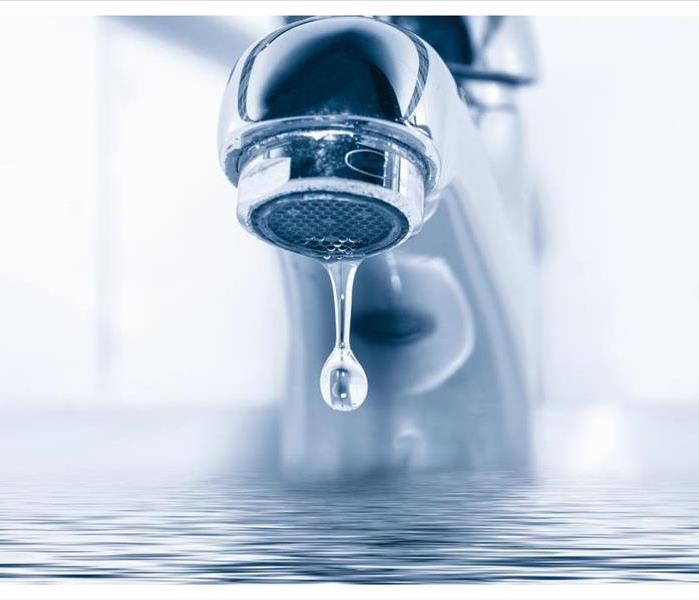 Check your appliances for leaks!
Check your appliances for leaks!
No one in Louisa, VA, wants to experience gushing water in home spaces, or pooling water on adjacent areas, such as a porch or patio. Water damage is ruinous, work intensive and costly no matter where it occurs. And while no one can predict a malfunctioning dishwasher or a broken pipe, you can take a number of easy-to-do steps to lessen the chances of an emergency requiring water damage repair and restoration services. Maintenance is the operative word. Keep in mind that standard homeowner's insurance covers water damage, but not if that damage resulted from a lack of proper maintenance.
To keep your home water damage-safe, here are some basic preventive measures.
Indoors
Check appliances regularly for leaks or gathering moisture. Make small fixes—a broken pipe and pipe cleanup, for example—to ward off big repairs stemming from outright flooding or mildew, mold and structural damage.
Replace old, brittle washing machine hoses prone to cracking.
Ensure your home's water pressure is not so high that it puts undue stress on pipes and hoses.
Track water bills to spot gradually increasing or spiking costs that can indicate hidden leaks.
Shut off the water main valve when your home is unoccupied for a long period.
Test your sump pump for operability.
Outdoors
Disconnect water hoses in winter to prevent frozen pipes that can burst and damage your home's interior.
Clean gutters and downspouts to free them of blockages that can harm the house foundation.
Inspect the roof and repair missing or cracked shingles to prevent leaking water in home interior areas.
Repoint loose chimney mortar and repair cracked bricks—another water entry point.
Keep landscaping clear of utility pipes to stop tree roots from splintering a water pipe.
Prevention is a proven strategy for all homeowners. It goes a long way toward avoiding the anguish and expense of finding unwanted water in home interiors—especially yours.
Broken Pipe
1/14/2020 (Permalink)
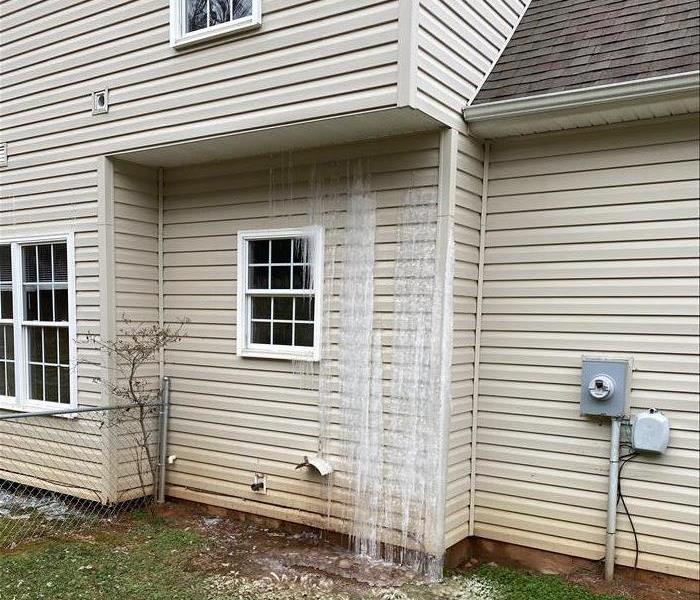 Frozen water from a large loss
Frozen water from a large loss
This picture depicts what happens when several hundreds of gallons of water run through the exterior walls of a home and the water freezes to the outside. Unfortunately for this home owner, the tenant had vacated the home, the pipe broke almost immediately after leaving, then the loss was not discovered for 10 days. The meter was read when the tenant vacated, it was then read the morning SERVPRO responded to provide services, we discovered that approximately 1,249 gallons of water ran through this home in almost 10 days! We performed a fair amount of demolition, set our drying equipment, and dried the home in a timely fashion. Just a tip to all our readers, if you vacate a home for an extended period of time, shutting the main water valve to the home will help to avoid such a disaster.




 24/7 Emergency Service
24/7 Emergency Service











